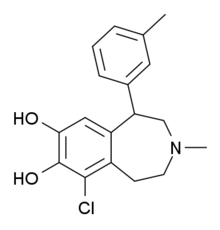SKF-83,959
Appearance
 | |
| Identifiers | |
|---|---|
| |
| PubChem CID | |
| ChemSpider | |
| ChEMBL | |
| Chemical and physical data | |
| Formula | C18H20ClNO2 |
| Molar mass | 317.81 g·mol−1 |
| 3D model (JSmol) | |
| |
| |
| (verify) | |
SKF-83,959 is a synthetic benzazepine derivative used in scientific research which acts as an agonist at the D1-D2 dopamine receptor.[1] It behaves as a full agonist at the D1 protomer and a high-affinity partial agonist at the D2 protomer. It was further shown to act as an allosteric modulator of the sigma-1 receptor.[2] SKF-83,959 is a racemate that consists of the R-(+)- and S-(−)-enantiomers MCL 202 and MCL 201, respectively. SKF-83,959 inhibits sodium channels[3] as well as delayed rectifier potassium channels.[4]
References
- ^ Rashid AJ, So CH, Kong MM, et al. (2007). "D1-D2 dopamine receptor heterooligomers with unique pharmacology are coupled to rapid activation of Gq/11 in the striatum". Proc. Natl. Acad. Sci. U.S.A. 104 (2): 654–9. doi:10.1073/pnas.0604049104. PMC 1766439. PMID 17194762.
- ^ Guo L, Zhao J, Jin G, et al. (2013). "SKF83959 is a potent allosteric modulator of sigma-1 receptor". Mol. Pharmacol. 83 (3): 577–86. doi:10.1124/mol.112.083840. PMID 23295385.
- ^ Chu HY, Wu Q, Zhou S, et al. (2011). "SKF83959 suppresses excitatory synaptic transmission in rat hippocampus via a dopamine receptor-independent mechanism". J. Neurosci. Res. 89 (8): 1259–66. doi:10.1002/jnr.22653. PMID 21538463.
- ^ Chen XQ, Zhang J, Neumeyer JL, et al. (2009). "Arylbenzazepines are potent modulators for the delayed rectifier K+ channel: a potential mechanism for their neuroprotective effects". PLoS ONE. 4 (6): e5811. doi:10.1371/journal.pone.0005811. PMC 2690691. PMID 19503734.
{{cite journal}}: CS1 maint: unflagged free DOI (link)
Further reading
- Lee SM, Yang Y, Mailman RB (2014). "Dopamine D1 receptor signaling: Does GαQ-phospholipase C actually play a role?". J. Pharmacol. Exp. Ther. 351: 9–17. doi:10.1124/jpet.114.214411. PMC 4165024. PMID 25052835.
- Lee SM, Kant A, Blake D, et al. (2014). "SKF-83959 is not a highly-biased functionally selective D1 dopamine receptor ligand with activity at phospholipase C". Neuropharmacology. 86: 145–54. doi:10.1016/j.neuropharm.2014.05.042. PMC 4188748. PMID 24929112.
